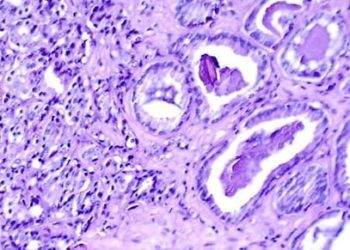2 Minute Medicine Rewind March 27, 2023
1. In this retrospective cohort study, the observed increase in the incidence of gestational diabetes was attributable to changes in screening practices rather than changing population factors in British Colombia, Canada.
Evidence Rating Level: 2 (Good)
Rates of gestational diabetes (GDM) are rising worldwide. Some suggest that population factors such as decreased physical activity and poor diet contribute to this observed increase in incidence. Alternatively, it is also theorized that these changes may be attributed to the increased sensitivity of screening arising from guideline changes in recent years. This retrospective cohort study sought to further investigate this, and examined 551 457 pregnancies, identified from the population-based BC Perinatal Data Registry, that underwent GDM screening between July 2004 and June 2019, to determine the extent to which changes in screening completion, screening method, and population-level characteristics contribute to the rise in gestational diabetes in BC, Canada. The rate of gestational diabetes increased from 7.2% of pregnancies in 2005 to 14.7% in 2019, representing a 2.04 (95% CI 1.94–2.13) increase in the risk of GDM. Screening completion rates, the use of 1-step screening, and population characteristics such as pre-pregnancy BMI, maternal age, and risk factors for poor obstetric outcomes also increased throughout the study period. After adjusting for the increase in screening completion, the risk of GDM in 2019 was attenuated to a 1.89-fold (95% CI 1.81–1.98) increase. After accounting for the screening method, the risk of GDM was attenuated to a 1.34-fold (95% CI 1.28–1.40) increase. Finally, adjustment for changes in population characteristics had a minor impact on the increased risk of GDM in 2019 compared with 2005 (1.25, 95% CI 1.19–1.31). These results suggest that changes in screening methods explained the majority of the increase in GDM from 2005 to 2019 in BC, Canada while changing population factors were not an important contributor. Therefore, instead of a true change in GDM incidence, new screening practices simply diagnose more cases of GDM. It is still uncertain whether the long-term benefits of decreases in cardiometabolic diseases or metabolic effects in GDM-identified offspring justify the drawbacks of an increased diagnostic burden.
1. In this retrospective cohort study, individuals with diabetes treated with metformin had a significantly lower risk of developing osteoarthritis compared to those treated with sulfonylurea.
Evidence Rating Level: 2 (Good)
Osteoarthritis (OA) affects 32.5 million people in the United States and is a major contributor to global years lived with disability. Currently, there are no effective medications that can stop, slow, or reverse the progression of OA. In addition to its use as a first-line treatment for type 2 diabetes, there is emerging evidence that metformin may be useful in preventing OA. Previous observational studies have focused on the progression of OA rather than its initial development and failed to isolate metformin’s effect from concomitant antidiabetic medication use. This large retrospective cohort study aimed to fill these gaps by evaluating the risk of developing OA and requiring joint replacement in diabetic individuals treated with metformin compared to sulfonylurea. The study used the Optum Clinformatics Data Mart Database, a large deidentified nationwide database that includes more than 15 million individuals annually. From this dataset, 20 937 individuals aged 40 years or older with type 2 diabetes and no prior diagnosis of OA or previous joint replacement were identified for each treatment group. After adjusting for confounders, individuals who received metformin were 24% less likely to develop OA compared to those treated with a sulfonylurea (P < .001). However, there was no significant reduction in the risk of undergoing a joint replacement. In a stratified analysis comparing those treated with metformin alone versus those treated with a sulfonylurea with prior metformin use, there was no longer a statistically significant reduction in the risk of developing OA. This finding may suggest that previous exposure to metformin afforded some level of long-term protection against OA development. Overall, the study found a significant association between metformin treatment and a reduction in the risk of developing OA compared to sulfonylurea treatment, a finding that supports previous literature. The study was limited by a lack of data on body mass index, which is associated with OA development. Metformin treatment may induce a decrease in body mass index, which may account for its protective effect against the development of OA. Nevertheless, further studies on metformin as an intervention to treat or prevent OA should be considered, especially given the limited therapeutic options for OA currently.
1. In this retrospective cohort study of infants exposed to SARS-CoV-2 in utero, there was a significantly higher risk of neurodevelopmental diagnoses in male offspring but not female offspring at 12 months following birth.
Evidence Rating Level 2: (Good)
Several epidemiologic studies have suggested that maternal infection or immune activation during pregnancy may be associated increased risk of neurodevelopmental disorders among offspring. In light of the COVID-19 pandemic, there is a need to understand whether maternal exposure may have similar effects on offspring as those reported in the literature for other infections. Prior studies have found a potential association between in utero infections and subsequent adverse neurodevelopmental outcomes, though prior literature suffered from small sample sizes and short follow-up periods. To address this, this retrospective cohort study assessed a large cohort of 18 355 live births from electronic health records from 8 hospitals in Eastern Massachusetts, to determine whether there are sex-specific differences in the development of neurodevelopmental disorders with SARS-CoV-2 exposure in utero, compared with unexposed offspring born during or before the COVID-19 pandemic. After adjusting for potential confounders, maternal SARS-Cov-2 positivity was associated with a statistically significant increased risk of neurodevelopmental diagnoses at 12 months among male offspring (adjusted OR, 1.94 [95% CI, 1.12-3.17]; P = .01), but not female offspring (adjusted OR, 0.89 [95% CI, 0.39-1.76]; P = .77). When extending follow-up to 18 months, there was a similar pattern of greater numerical increase in adverse neurodevelopmental outcomes in male offspring but not in female offspring. However, these findings were not statistically significant, with all 95% CIs including 1. This is likely due in part to the smaller cohort size at the 18-month mark, compared to the 12-month mark. Overall these findings suggest that male offspring exposed to SARS-CoV-2 infection in utero may be at a higher risk for adverse neurodevelopmental outcomes. Given that both SARS-CoV-2-positive and uninfected mothers were exposed to pandemic-era stress, these effects are not primarily due to pandemic factors, rather they are likely attributable to infection exposure itself. Further studies with larger cohorts and extended follow-up are required to accurately assess and characterize the risk.
1. In this large retrospective matched cohort study of women aged 18-40 years, a history of abnormal menstruation was associated with an increased risk of cardiometabolic outcomes in later life
Evidence Rating Level: 2 (Good)
According to estimates from the global burden of disease study, cardiovascular disease (CVD) is the leading cause of mortality in women accounting for 35% of total deaths worldwide. Menstrual cycle history and its link to CVD are not mentioned in recent literature reviews and consensus statements, which support the association between female reproductive factors and the risk of CVD in later life. Long or irregular menstrual cycles are associated with cardiovascular risk factors including hyperinsulinemia, dyslipidemia, hypertension, and diabetes mellitus. Its management has predominantly focused on addressing infertility implications, leaving other potential longer-term risks such as CVD underappreciated. This retrospective cohort study utilizes electronic health data from UK primary care to investigate the association between menstrual cycle characteristics and long-term risk of cardiometabolic outcomes. From the study population of women aged 18-40 years two cohorts were created and matched to controls — one composed of 215,378 women with a history of irregular or absent menstrual cycles and the other composed of 36,947 women with infrequent or frequent menstrual cycles. Comparing women with irregular menstrual cycles to those with regular menstrual cycles the hazard ratio for composite CVD was 1.08 (95% CI 1.00–1.19; p = 0.062). Comparing infrequent or frequent menstruation to menstrual cycles of normal frequency, a hazard ratio for composite CVD of 1.24 (95% CI 1.02–1.52; p = 0.031) was observed. Both irregular menstrual cycles and frequent or infrequent cycles were linked with an increased risk of hypertension and type 2 diabetes mellitus. Overall, these findings suggest that a history of irregular, frequent, or infrequent menstrual cycles is associated with an increased risk of cardiometabolic outcomes later in life. This opens up an avenue to apply menstrual history as a screening tool to identify and periodically assess individuals at a higher risk of poor future cardiometabolic health.
1. This randomized control trial found that febuxostat has a reno-protective effect that can reduce the incidence of contrast-induced acute kidney injury in chronic kidney disease stage 3 patients undergoing percutaneous coronary intervention
Evidence Rating Level: 1 (Excellent)
Contrast-induced acute kidney injury (CI-AKI) is considered the third most common cause of AKI in hospitalized patients. Percutaneous coronary intervention (PCI) increases the incidence of CI-AKI, which is already gradually increasing. Although 80% of patients’ creatinine values return to baseline within 1 to 3 weeks after CI-AKI, some patients develop renal failure, leading to the initiation of renal replacement therapy, cardiovascular events, and an increased mortality rate. Prior literature has suggested that Febuxostat may have renoprotective properties in its hypouricemic and anti-inflammatory effects, which are thought to combat mechanisms leading to CI-AKI. This randomized control trial aimed to evaluate the reno-protective effect of febuxostat in the prevention of CI-AKI in stage 3 CKD patients undergoing PCI. The trial enrolled 120 stage 3 CKD patients with acute coronary syndrome who were scheduled to undergo PCI at Ain-Shams University hospital. Patients were randomly assigned to two arms — one study arm consisting of 60 patients who received Febuxostat 80 mg within 6–18 h before and after the procedure with an interval of 24 h between the two doses, and a control group of 60 patients who received traditional treatment only. Patients were stratified to low, moderate, high, and very high risk of AKI according to their calculated Mehran risk score. The incidence of AKI was 25% in the control group and 11.7% in the study group (p-value = 0.048). Aside from febuxostat avoidance, the only other statistically significant independent risk factors of CI-AKI incidence were the Mehran score and baseline serum creatine. Overall, this randomized control trial demonstrates that febuxostat has reno-protective effects that can reduce CI-AKI incidence in stage 3 CKD patients undergoing PCI. Given the absence of adverse events in this study and the demonstrated protection febuxostat affords against CI-AKI, its use should be strongly considered in stage 3 CKD patients.
Image: PD
©2023 2 Minute Medicine, Inc. All rights reserved. No works may be reproduced without expressed written consent from 2 Minute Medicine, Inc. Inquire about licensing here. No article should be construed as medical advice and is not intended as such by the authors or by 2 Minute Medicine, Inc.







